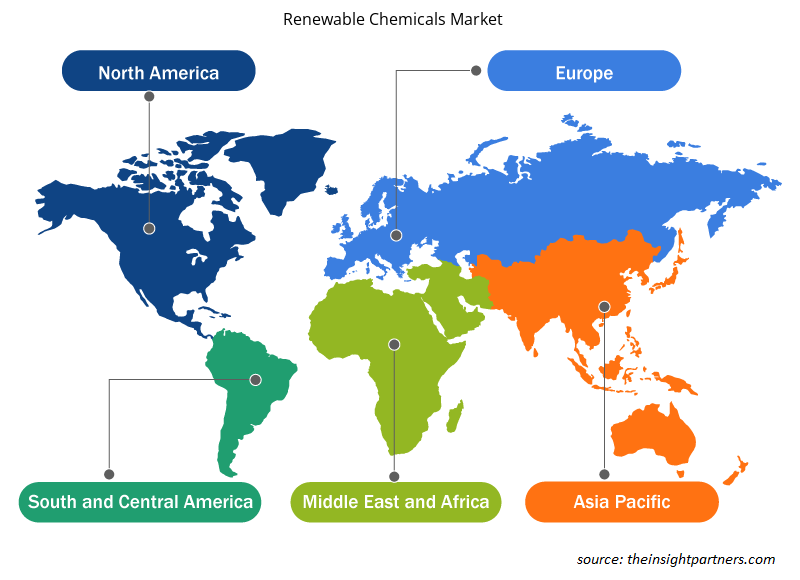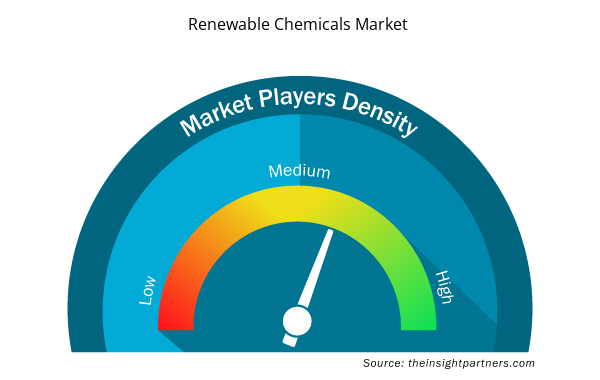2021 年可再生化学品市场价值为 805.663 亿美元,预计 2021 年至 2028 年的复合年增长率为11.9 %。
可再生化学品或生物基化学品是指由农业 原料、农业废弃物、有机废弃物、生物质和微生物等可再生资源合成的化学品类别。可再生化学品被归类为可持续和环境友好型化学品,与传统石油基化学品相比,其碳足迹更少。一些最广泛使用的可再生化学品包括木质素、碳水化合物、油、植物提取物、半纤维素、纤维素、淀粉、蛋白质等。此类化学品可用于食品和饮料、农业、纺织、汽车、包装等各种应用领域。
2021 年,北美在全球可再生化学品市场中占据最大份额。该地区可再生化学品市场的主导地位主要归因于强大的工业基础,知名制造业为市场增长做出了重大贡献。食品和饮料、农业、纺织、运输、包装和其他行业对可再生化学品的需求很高,而终端工业基地的大幅增长刺激了区域市场对可再生化学品的需求。制造业投资的增加以及对环保和可持续解决方案的日益关注,为北美可再生化学品市场的增长提供了丰厚的机会。此外,鼓励使用生物基和可再生化学品取代传统石油基化学品的优惠政策预计将进一步为该地区创造丰厚的增长机会。
定制此报告以满足您的需求
您可以免费定制任何报告,包括本报告的部分内容、国家级分析、Excel 数据包,以及为初创企业和大学提供优惠和折扣
- 获取此报告的关键市场趋势。这个免费样品将包括数据分析,从市场趋势到估计和预测。
COVID-19 疫情对可再生化学品市场的影响
持续的疫情彻底改变了工业部门的现状,对可再生化学品市场的增长产生了负面影响。为防止病毒传播而采取的措施加剧了形势,影响了多个工业部门的增长。由于国家和国际边界突然关闭,运营效率突然扭曲,价值链中断,食品和饮料、农业、纺织、运输、包装、制药等行业都受到了影响。多个工业部门的增长大幅下降,对全球市场对可再生化学品的需求产生了负面影响。由于无限期封锁和临时隔离,从供应商采购原材料的中断以及制造基地的暂时关闭,影响了疫情期间市场的增长。然而,随着各经济体计划恢复运营,全球对可再生化学品的需求预计将上升。尽管对即时生产的关注是阻碍市场增长的另一个令人担忧的因素。食品和饮料、农业、纺织、运输、包装、制药和其他行业对可再生化学品的需求不断扩大,以及知名制造商的大量投资,预计将推动可再生化学品的增长。
市场洞察
随着人们对环境问题的关注度不断提高,人们对可再生化学品的认识也不断提高
可再生科学被视为改善空气、水和土壤质量的有效方法之一,并通过在各种应用中商业化使用环保的生物基化学品来促进可持续发展。环保的可持续可再生化学品可以通过绿色化学合成或生物精炼厂从可再生原料(如生物质、农业残留物或原料)和微生物中获取。一些经济体的政府已经实施了与碳和温室气体排放有关的严格法规,以促进高质量的环境。例如,欧盟委员会的目标是到 2050 年通过逐步淘汰用于熟料生产的约 8100 万吨二氧化碳,将碳排放量减少 80%。REACH(化学品注册、评估、授权和限制)、EPA(环境保护署)和欧盟委员会等监管机构对石化产品的生产和处置实施了严格的环境法规。此外,欧盟日益重视建立“绿色经济”,并推出了“20-20-20”计划,这正在逐步减少对石化产品的需求。石油资源的减少,加上主要产油国的政治不稳定和石油产品价格的波动,增加了人们对可再生化学品的偏好。全球变暖和气候变化正在创造对健康、绿色和清洁产品的需求。此外,循环经济正在为开发环保技术(包括与可再生化学品相关的技术)创造价值超过 5.6 万亿美元的新机遇。这些合作努力、法规和举措推动了可再生化学品市场的增长。
产品洞察
根据产品,可再生化学品市场分为醇、有机酸、酮、平台化学品、生物聚合物等。生物聚合物部门预计将成为预测期内全球可再生化学品市场中增长最快的部门。对绿色包装材料的需求不断增长,加上汽车行业对生物聚合物的使用日益增多,预计将推动可再生化学品市场中生物聚合物的增长。生物聚合物包括多核苷酸(DNA、RNA)、纤维素、壳聚糖、甲壳质、淀粉、蛋白质、聚酯、果胶、胶原蛋白、明胶和麸质等。它们是减少温室气体和有毒物质排放以及不可再生资源使用的创新且有前途的替代品。对环保和可持续材料的日益关注预计将推动对生物聚合物的需求。
应用程序洞察
根据应用,可再生化学品市场分为食品和饮料、农业、纺织品、运输、化学中间体、包装、生物医学和制药等。2021 年,运输部门将主导可再生化学品市场。生物质、木屑、农作物残渣等被转化为可再生运输燃料。各种类型的生物基醇,如生物丁醇、生物乙醇和生物甲醇,被用作喷气式飞机的燃料。生物乙醇是运输中最广泛使用的能源。预计未来几年生物乙醇的使用将大幅增加,并保持高位。这种向更多生物乙醇使用的转变将在未来提供更多机会。甲烷是另一种用作运输燃料的可再生化学品,是压缩天然气的主要成分。它是由生物质通过一种称为厌氧消化的生化过程产生的。生物柴油是一种可再生柴油燃料替代品,通过将任何天然油或脂肪与酒精(通常是甲醇)混合而产生。不同的植物油、动物脂肪和回收的食用油脂也可以转化为生物柴油。
可再生化学品市场的主要参与者包括巴斯夫 SE、Amyris Inc、DSM、阿彻丹尼尔斯米德兰公司 (ADM) 和陶氏化学公司。这些市场参与者高度关注高质量和创新产品的开发。
可再生化学品市场区域洞察
Insight Partners 的分析师已详尽解释了预测期内影响可再生化学品市场的区域趋势和因素。本节还讨论了北美、欧洲、亚太地区、中东和非洲以及南美和中美洲的可再生化学品市场细分和地理位置。

- 获取可再生化学品市场的区域特定数据
可再生化学品市场报告范围
| 报告属性 | 细节 |
|---|---|
| 2021 年市场规模 | 805.7亿美元 |
| 2028 年市场规模 | 1767.5亿美元 |
| 全球复合年增长率(2021 - 2028) | 11.9% |
| 史料 | 2019-2020 |
| 预测期 | 2022-2028 |
| 涵盖的领域 | 按产品
|
| 覆盖地区和国家 | 北美
|
| 市场领导者和主要公司简介 |
|
可再生化学品市场参与者密度:了解其对业务动态的影响
可再生化学品市场正在快速增长,这得益于终端用户需求的不断增长,而这些需求又源于消费者偏好的不断变化、技术进步以及对产品优势的认识不断提高等因素。随着需求的增加,企业正在扩大其产品范围,进行创新以满足消费者的需求,并利用新兴趋势,从而进一步推动市场增长。
市场参与者密度是指在特定市场或行业内运营的企业或公司的分布情况。它表明在给定市场空间中,相对于其规模或总市场价值,有多少竞争对手(市场参与者)存在。
在可再生化学品市场运营的主要公司有:
- 阿彻丹尼尔斯米德兰公司 (ADM)
- 嘉吉公司
- 帝斯曼
- 巴斯夫欧洲公司。
- 阿米瑞斯公司(Amyris Inc.)
免责声明:上面列出的公司没有按照任何特定顺序排列。

- 了解可再生化学品市场的主要参与者概况
报告亮点
- 可再生化学品市场的进步行业趋势有助于参与者制定有效的长期战略
- 发达市场和发展中市场采用的业务增长战略
- 2019 年至 2028 年可再生化学品市场的定量分析
- 全球可再生化学品需求估计
- PEST 分析可说明行业内买家和供应商的效率
- 了解竞争市场状况的最新发展
- 市场趋势和前景以及推动和抑制可再生化学品市场增长的因素
- 通过强调支撑商业利益的市场策略来协助决策过程,从而促进市场增长
- 市场的详细概述和细分,以及可再生化学品行业动态
- 各地区可再生化学品市场规模及增长机遇
可再生化学品市场(按产品划分)
- 酒精
- 有机酸
- 酮体
- 平台化学品
- 生物聚合物
- 其他的
可再生化学品市场(按应用划分)
- 食品和饮料
- 农业
- 纺织品
- 运输
- 化学中间体
- 包装
- 生物医学和制药
- 其他的
公司简介
- 阿彻丹尼尔斯米德兰公司 (ADM)
- 嘉吉公司
- 帝斯曼
- 巴斯夫
- 阿米瑞斯公司
- 赢创工业集团
- 索尔维
- 陶氏化学公司
- Genomatica 公司
- 巴西石化公司
- 历史分析(2 年)、基准年、预测(7 年)及复合年增长率
- PEST 和 SWOT 分析
- 市场规模价值/数量 - 全球、区域、国家
- 行业和竞争格局
- Excel 数据集



Report Coverage
Revenue forecast, Company Analysis, Industry landscape, Growth factors, and Trends

Segment Covered
This text is related
to segments covered.

Regional Scope
North America, Europe, Asia Pacific, Middle East & Africa, South & Central America

Country Scope
This text is related
to country scope.
常见问题
Europe is estimated to register the fastest CAGR in the market over the forecast period. The increasing investment by European Union towards the development of the ‘Green Economy’ is expected to contribute to market growth. The European government is actively involved in implementing crucial initiatives to promote the use of renewable chemicals, which is expected to provide impetus to market growth in the region.
Biopolymers segment is the fastest growing segment in the global renewable chemicals market during the forecasted period. The expanding demand for green packaging materials coupled with the increasing use of biopolymers in automotive industry is projected to drive the growth of the biopolymers in renewable chemicals market. They are an innovative and promising alternative to reduce greenhouse gas and toxic emissions, and the use of non-renewable resources.
Among the eight segments of application, transportation segment has led the renewable chemicals market in 2020. The biomass, wood chips, crop residues etc. are converted to renewable transportation fuels. The various types of bio-based alcohols like bio-butanol, bio-ethanol, and bio-methanol are used as fuel in jets. Bio-ethanol is the most widely used source of energy for transportation. The use of bio-ethanol is projected to increase significantly in coming years and remain high. This shift toward more bio-ethanol usage will provide more opportunities in future. Methane is another renewable chemical used as transportation fuel and is the major component of compressed natural gas.
The major players operating in the global renewable chemicals market are Archer-Daniels-Midland Company (ADM).; Cargill Inc.; DSM; BASF SE.; Amyris Inc.; Evonik Industries AG.; Solvay; The Dow Chemical Company.; Genomatica, Inc. and Braskem among many others.
In 2020, North America contributed to the largest share in the global renewable chemicals market. The dominance of the renewable chemicals market in this region is primarily attributable to the presence of strong industrial base with prominent manufactures significantly contributing to market growth. High demand of renewable chemicals from applications such as food and beverages, agriculture, textiles, transportation, packaging and other industries backed by significant growth in end-use industrial bases is stimulating the demand for renewable chemicals in regional market. Furthermore, favorable policies to promote the use of biobased and renewable chemicals over conventional petroleum-based chemicals is further expected to create lucrative growth opportunities in the region.
Among the six segments of product, alcohol segment has led the renewable chemicals market in 2020. Renewable alcohols are produced from a wide range of biomass or biological resources such as crops, farm residues, wood and wood residue, food waste, and solid waste. Renewable alcohols or bio-based alcohols includes biomethanol, bioethanol, biopropanol, biobutanol etc. Due to depleting petroleum reserves and the environmental impact of fossil fuels, the importance of bio-based alcohol fuels is increasing as an alternative solution.
Trends and growth analysis reports related to Chemicals and Materials : READ MORE..
The List of Companies - Renewable Chemicals Market
- Archer-Daniels-Midland Company (ADM)
- Cargill Inc
- DSM
- BASF SE.
- Amyris Inc.
- Evonik Industries AG
- Solvay
- The Dow Chemical Company.
- Genomatica, Inc.
- Braskem
The Insight Partners performs research in 4 major stages: Data Collection & Secondary Research, Primary Research, Data Analysis and Data Triangulation & Final Review.
- Data Collection and Secondary Research:
As a market research and consulting firm operating from a decade, we have published and advised several client across the globe. First step for any study will start with an assessment of currently available data and insights from existing reports. Further, historical and current market information is collected from Investor Presentations, Annual Reports, SEC Filings, etc., and other information related to company’s performance and market positioning are gathered from Paid Databases (Factiva, Hoovers, and Reuters) and various other publications available in public domain.
Several associations trade associates, technical forums, institutes, societies and organization are accessed to gain technical as well as market related insights through their publications such as research papers, blogs and press releases related to the studies are referred to get cues about the market. Further, white papers, journals, magazines, and other news articles published in last 3 years are scrutinized and analyzed to understand the current market trends.
- Primary Research:
The primarily interview analysis comprise of data obtained from industry participants interview and answers to survey questions gathered by in-house primary team.
For primary research, interviews are conducted with industry experts/CEOs/Marketing Managers/VPs/Subject Matter Experts from both demand and supply side to get a 360-degree view of the market. The primary team conducts several interviews based on the complexity of the markets to understand the various market trends and dynamics which makes research more credible and precise.
A typical research interview fulfils the following functions:
- Provides first-hand information on the market size, market trends, growth trends, competitive landscape, and outlook
- Validates and strengthens in-house secondary research findings
- Develops the analysis team’s expertise and market understanding
Primary research involves email interactions and telephone interviews for each market, category, segment, and sub-segment across geographies. The participants who typically take part in such a process include, but are not limited to:
- Industry participants: VPs, business development managers, market intelligence managers and national sales managers
- Outside experts: Valuation experts, research analysts and key opinion leaders specializing in the electronics and semiconductor industry.
Below is the breakup of our primary respondents by company, designation, and region:

Once we receive the confirmation from primary research sources or primary respondents, we finalize the base year market estimation and forecast the data as per the macroeconomic and microeconomic factors assessed during data collection.
- Data Analysis:
Once data is validated through both secondary as well as primary respondents, we finalize the market estimations by hypothesis formulation and factor analysis at regional and country level.
- Macro-Economic Factor Analysis:
We analyse macroeconomic indicators such the gross domestic product (GDP), increase in the demand for goods and services across industries, technological advancement, regional economic growth, governmental policies, the influence of COVID-19, PEST analysis, and other aspects. This analysis aids in setting benchmarks for various nations/regions and approximating market splits. Additionally, the general trend of the aforementioned components aid in determining the market's development possibilities.
- Country Level Data:
Various factors that are especially aligned to the country are taken into account to determine the market size for a certain area and country, including the presence of vendors, such as headquarters and offices, the country's GDP, demand patterns, and industry growth. To comprehend the market dynamics for the nation, a number of growth variables, inhibitors, application areas, and current market trends are researched. The aforementioned elements aid in determining the country's overall market's growth potential.
- Company Profile:
The “Table of Contents” is formulated by listing and analyzing more than 25 - 30 companies operating in the market ecosystem across geographies. However, we profile only 10 companies as a standard practice in our syndicate reports. These 10 companies comprise leading, emerging, and regional players. Nonetheless, our analysis is not restricted to the 10 listed companies, we also analyze other companies present in the market to develop a holistic view and understand the prevailing trends. The “Company Profiles” section in the report covers key facts, business description, products & services, financial information, SWOT analysis, and key developments. The financial information presented is extracted from the annual reports and official documents of the publicly listed companies. Upon collecting the information for the sections of respective companies, we verify them via various primary sources and then compile the data in respective company profiles. The company level information helps us in deriving the base number as well as in forecasting the market size.
- Developing Base Number:
Aggregation of sales statistics (2020-2022) and macro-economic factor, and other secondary and primary research insights are utilized to arrive at base number and related market shares for 2022. The data gaps are identified in this step and relevant market data is analyzed, collected from paid primary interviews or databases. On finalizing the base year market size, forecasts are developed on the basis of macro-economic, industry and market growth factors and company level analysis.
- Data Triangulation and Final Review:
The market findings and base year market size calculations are validated from supply as well as demand side. Demand side validations are based on macro-economic factor analysis and benchmarks for respective regions and countries. In case of supply side validations, revenues of major companies are estimated (in case not available) based on industry benchmark, approximate number of employees, product portfolio, and primary interviews revenues are gathered. Further revenue from target product/service segment is assessed to avoid overshooting of market statistics. In case of heavy deviations between supply and demand side values, all thes steps are repeated to achieve synchronization.
We follow an iterative model, wherein we share our research findings with Subject Matter Experts (SME’s) and Key Opinion Leaders (KOLs) until consensus view of the market is not formulated – this model negates any drastic deviation in the opinions of experts. Only validated and universally acceptable research findings are quoted in our reports.
We have important check points that we use to validate our research findings – which we call – data triangulation, where we validate the information, we generate from secondary sources with primary interviews and then we re-validate with our internal data bases and Subject matter experts. This comprehensive model enables us to deliver high quality, reliable data in shortest possible time.


 获取此报告的免费样本
获取此报告的免费样本